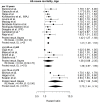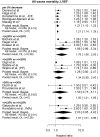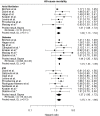Predictors of mortality and ICD shock therapy in primary prophylactic ICD patients-A systematic review and meta-analysis
- PMID: 29040341
- PMCID: PMC5645142
- DOI: 10.1371/journal.pone.0186387
Predictors of mortality and ICD shock therapy in primary prophylactic ICD patients-A systematic review and meta-analysis
Abstract
Background: There is evidence that the benefit of a primary prophylactic ICD therapy is not equal in all patients.
Purpose: To evaluate risk factors of appropriate shocks and all- cause mortality in patients with a primary prophylactic ICD regarding contemporary studies.
Data source: PubMed, LIVIVO, Cochrane CENTRAL between 2010 and 2016.
Study selection: Studies were eligible if at least one of the endpoints of interest were reported.
Data extraction: All abstracts were independently reviewed by at least two authors. The full text of all selected studies was then analysed in detail.
Data synthesis: Our search strategy retrieved 608 abstracts. After exclusion of unsuitable studies, 36 papers with a total patient number of 47282 were included in our analysis. All-cause mortality was significantly associated with increasing age (HR 1.41, CI 1.29-1.53), left ventricular function (LVEF; HR 1.21, CI 1.14-1.29), ischemic cardiomyopathy (ICM; HR 1.37, CI 1.14-1.66) and co-morbidities such as impaired renal function (HR 2.30, CI 1.97-2.69). Although, younger age (HR 0.96, CI 0.85-1.09), impaired LVEF (HR 1.26, CI 0.89-1.78) and ischemic cardiomyopathy (HR 2.22, CI 0.83-5.93) were associated with a higher risk of appropriate shocks, none of these factors reached statistical significance.
Limitations: Individual patient data were not available for most studies.
Conclusion: In this meta-analysis of contemporary clinical studies, all-cause mortality is predicted by a variety of clinical characteristics including LVEF. On the other hand, the risk of appropriate shocks might be associated with impaired LVEF and ischemic cardiomyopathy. Further prospective studies are required to verify risk factors for appropriate shocks other than LVEF to help select appropriate patients for primary prophylactic ICD-therapy.
Conflict of interest statement
Figures













Similar articles
-
A review of the evidence on the effects and costs of implantable cardioverter defibrillator therapy in different patient groups, and modelling of cost-effectiveness and cost-utility for these groups in a UK context.Health Technol Assess. 2006 Aug;10(27):iii-iv, ix-xi, 1-164. doi: 10.3310/hta10270. Health Technol Assess. 2006. PMID: 16904046
-
Systemic pharmacological treatments for chronic plaque psoriasis: a network meta-analysis.Cochrane Database Syst Rev. 2021 Apr 19;4(4):CD011535. doi: 10.1002/14651858.CD011535.pub4. Cochrane Database Syst Rev. 2021. Update in: Cochrane Database Syst Rev. 2022 May 23;5:CD011535. doi: 10.1002/14651858.CD011535.pub5. PMID: 33871055 Free PMC article. Updated.
-
Implantable Cardioverter-Defibrillators for Primary Prevention in Patients With Ischemic or Nonischemic Cardiomyopathy: A Systematic Review and Meta-analysis.Ann Intern Med. 2017 Jul 18;167(2):103-111. doi: 10.7326/M17-0120. Epub 2017 Jun 27. Ann Intern Med. 2017. PMID: 28632280
-
Gender Differences in Appropriate Shocks and Mortality among Patients with Primary Prophylactic Implantable Cardioverter-Defibrillators: Systematic Review and Meta-Analysis.PLoS One. 2016 Sep 12;11(9):e0162756. doi: 10.1371/journal.pone.0162756. eCollection 2016. PLoS One. 2016. PMID: 27618617 Free PMC article.
-
Impact of residual disease as a prognostic factor for survival in women with advanced epithelial ovarian cancer after primary surgery.Cochrane Database Syst Rev. 2022 Sep 26;9(9):CD015048. doi: 10.1002/14651858.CD015048.pub2. Cochrane Database Syst Rev. 2022. PMID: 36161421 Free PMC article.
Cited by
-
Rationale and design of the SafeHeart study: Development and testing of a mHealth tool for the prediction of arrhythmic events and implantable cardioverter-defibrillator therapy.Cardiovasc Digit Health J. 2021 Oct 13;2(6 Suppl):S11-S20. doi: 10.1016/j.cvdhj.2021.10.002. eCollection 2021 Dec. Cardiovasc Digit Health J. 2021. PMID: 35265921 Free PMC article.
-
Rationale and design of the EU-CERT-ICD prospective study: comparative effectiveness of prophylactic ICD implantation.ESC Heart Fail. 2019 Feb;6(1):182-193. doi: 10.1002/ehf2.12367. Epub 2018 Oct 9. ESC Heart Fail. 2019. PMID: 30299600 Free PMC article.
-
Fragmented QRS is associated with ventricular arrhythmias in heart failure patients: A systematic review and meta-analysis.Ann Noninvasive Electrocardiol. 2022 Jan;27(1):e12910. doi: 10.1111/anec.12910. Epub 2021 Nov 11. Ann Noninvasive Electrocardiol. 2022. PMID: 34766402 Free PMC article.
References
-
- Priori SG, Blomstrom-Lundqvist C, Mazzanti A, Blom N, Borggrefe M, Camm J, et al. 2015 ESC Guidelines for the management of patients with ventricular arrhythmias and the prevention of sudden cardiac death: The Task Force for the Management of Patients with Ventricular Arrhythmias and the Prevention of Sudden Cardiac Death of the European Society of Cardiology (ESC). Endorsed by: Association for European Paediatric and Congenital Cardiology (AEPC). Eur Heart J. 2015; 36: 2793–2867. doi: 10.1093/eurheartj/ehv316 - DOI - PubMed
-
- Moss AJ, Zareba W, Hall WJ, Klein H, Wilber DJ, Cannom DS, et al. Prophylactic implantation of a defibrillator in patients with myocardial infarction and reduced ejection fraction. N Engl J Med. 2002; 346: 877–883. doi: 10.1056/NEJMoa013474 - DOI - PubMed
-
- Bardy GH, Lee KL, Mark DB, Poole JE, Packer DL, Boineau R, et al. Amiodarone or an implantable cardioverter-defibrillator for congestive heart failure. N Engl J Med. 2005; 352: 225–237. doi: 10.1056/NEJMoa043399 - DOI - PubMed
-
- Kadish A, Dyer A, Daubert JP, Quigg R, Estes NAM, Anderson KP, et al. Prophylactic defibrillator implantation in patients with nonischemic dilated cardiomyopathy. N Engl J Med. 2004; 350: 2151–2158. doi: 10.1056/NEJMoa033088 - DOI - PubMed
-
- Arribas F, Auricchio A, Wolpert C, Merkely B, Merino JL, Boriani G, et al. The EHRA White Book. Europace. 2012; 14 Suppl 3: iii1–55. doi: 10.1093/europace/eus256 - DOI - PubMed
Publication types
MeSH terms
LinkOut - more resources
Full Text Sources
Other Literature Sources
Medical

